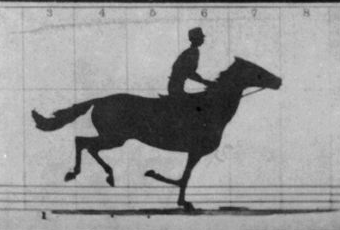
A man in motion, Eadweard Muybridge, was a classically trained photographer and one of the first people to take photos of Yosemite Valley, San Francisco, and Sacramento.
Born in England on the 9th of April, 1830, he moved to the United States as a young man. By 1867, he was famous for his large photographs of Yosemite.
At a time before motion pictures existed, he was hired by former Governor Leland Stanford to determine the answer to a question: When a horse is running, are all four of its feet ever off the ground?
Setting up quarters on at what is now Stanford University in a location near the Cantor Arts Center, Muybridge worked a number of years before he devised a method which answered the Stanford’s question.
In 1878, using a series of cameras laid out at regular intervals, he was able to capture sequential images of a horse running. He achieved this by using strings attached to cameras, which when broken by the running horse, triggered a shutter to open and catch a single, fleeting image.
Much like a flip book, the pictures he captured, watched in sequence, gave the illusion the horse was in movement and answered the question affirmatively: that when running, all four of the horse’s feet do leave the ground at times. 
As fascinating as this result was, it inspired him to further discoveries and the invention of the first movie camera by which he could reanimate the sequences he had captured. For the first time, people could envision things normally too quick for the human eye to perceive.
Muybridge’s initial discoveries led to his series on Animal Locomotion, and to the founding of our modern day film industry.
Muybridge was a mercurial man. In 1874, he shot and killed his wife’s lover and was acquitted for justifiable homicide. A serious head injury resulting from an accident with a runaway coach left him with brain damage requiring more than a year of active recuperation. He was left with a permanent lose of taste and smell. It’s been considered by at least one psychologist at UC Berkeley that damage to the orbitofrontalcortex extending into the temporal lobes resulting from that accident may have led him to eccentric behavior and also freed him from traditional social conventions, thus enabling his groundbreaking work.
For more on Muybridge’s work and impact, here’s a short and lovely movie except from the film Fog City Mavericks: Eadweard Muybridge Section by Gary Leva.
(Note: this is a reshare of a post from this time last year. )

I’m familiar with his photos, of course, but I’ve never read about his life. Crazy stuff–brain injury and drama! The link is a great video. Makes me want to see the whole thing. (I love documentaries…sigh.)
Thank you for including the video. It looks almost modern in its elegance and fluid motion. I love documentaries too, Roslynn. And theater rehearsals. And watching the Director’s Commentary on movie DVDs.
So interesting. I was somewhat familiar with his work but didn’t know much else about him. I certainly did not know about the head injury – fascinating stuff. Huzzah for documentaries, and director’s commentaries, and all the other, similar esoteric goodies!
Interesting post about a man I hadn’t heard of. Thanks.
Thanks. I just went to your blog. Did you change it? Your post, Dressed to Impress, is so cool. Utterly creative and fascinating clothes.
No, nothing changed yet, although I’m considering a change of theme or colour. The clothing was so clever.
That was interesting information! Thank you.